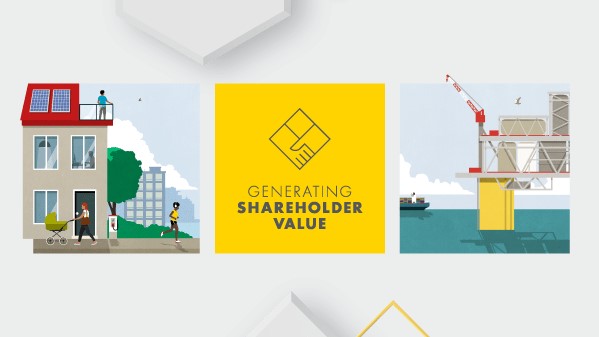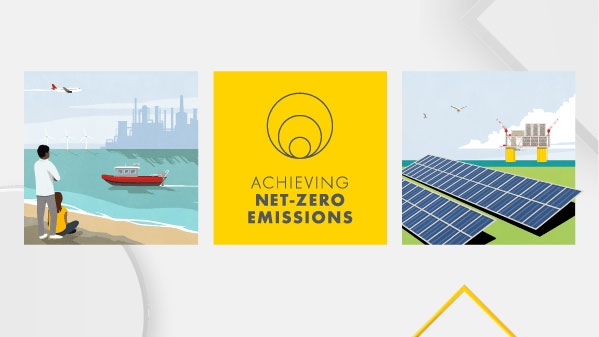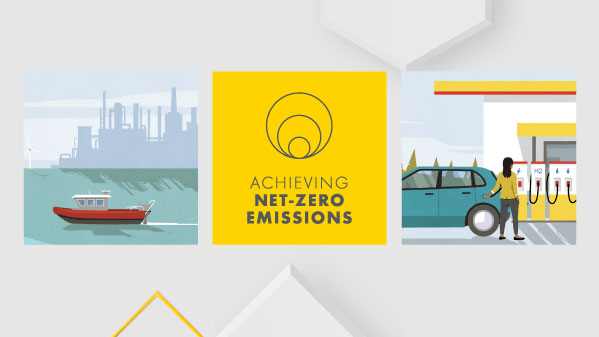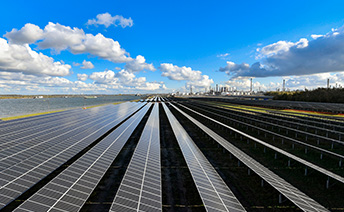Hydrogen Council
The Hydrogen Council is a global CEO-led initiative with a long-term ambition for hydrogen to foster the clean energy transition. The Hydrogen Council now includes almost 150 multinational companies representing the entire hydrogen value chain.[1]
Membership of board/executive committee: Shell is a member of the CEO board and management board.
- 2022 assessment outcome: Aligned
- 2021 assessment outcome: Aligned
Summary
Shell benefits from its membership of the Hydrogen Council, particularly in relation to its work and engagement to enable hydrogen and hydrogen policy. It also publishes hydrogen-related studies and provides a platform for government and companies to connect on hydrogen issues.
We have found the Hydrogen Council to be aligned with our climate and energy transition-related policy positions.
We will remain a member of the Hydrogen Council. We will continue to engage the association on climate and energy transition topics. We will continue to track alignment between the Hydrogen Council’s climate and energy transition-related positions and our own.
Further information
Click on the sections below to read more.
Paris Agreement and net-zero emissions
- The Hydrogen Council states that the organisation was established to “help limit global warming to 2°C, in accordance with the target set by the Paris Climate Agreement in 2015.”[2]
- In its November 2021 report ‘Hydrogen for Net-Zero’, the Hydrogen Council stated that “hydrogen has a central role in helping the world reach net-zero emissions by 2050 and limit global warming to 1.5 degrees Celsius.”[3]
- In its 2022 report, ‘Hydrogen Insights 2022’, the Hydrogen Council stated that “for the world to be on track for net zero emissions by 2050, investments of some USD 700 billion in hydrogen are needed through 2030.”[4]
- In a 2022 report on ‘Global Hydrogen Flows’, the Hydrogen Council stated that hydrogen will be needed as an energy carrier across several sectors to achieve carbon neutrality.[5]
Carbon pricing
- In its November 2021 ‘Policy Toolbox for Low Carbon and Renewable Hydrogen’, the Hydrogen Council stated that “robust carbon pricing mechanisms can incentivise hydrogen deployment” and that the support of robust carbon pricing is one of six pillars of efficient policy design for low-carbon and renewable hydrogen.[6]
- In 2022, the Hydrogen Council and the International Emissions Trading Association (IETA) held a roundtable session for their members, featuring government and business speakers, on the impact of the Glasgow Pact and the Article 6 Rulebook on carbon markets and on the uptake of renewable and low-carbon hydrogen.[7]
Energy efficiency
- The Hydrogen Council does not appear to have an explicit position relating to energy efficiency, but states that hydrogen “uniquely complements and enables other decarbonisation pathways such as […] energy efficiency measures”.[8] [9]
Decarbonised hydrogen
- The Hydrogen Council has stated: “Hydrogen is central to reaching net zero emissions.”[10] The Hydrogen Council includes hydrogen produced from natural gas coupled with CCS in its definition of low-carbon hydrogen, and states that both renewable and low-carbon hydrogen are complementary.[11]
- In its November 2021 ‘Policy Toolbox for Low Carbon and Renewable Hydrogen’, the Hydrogen Council identified key hydrogen policies based on their economic efficiency and effectiveness.[12]
- In its 2022 report, ‘Hydrogen Insights 2022’, the Hydrogen Council identified three priority policy actions for hydrogen in the period 2022-2023. These include “enabling demand visibility and regulatory certainty by adopting legally binding measures”, “fast-track access to public funding for hydrogen projects”, and “ensure international coordination and support credible common standards and robust tradeable certification systems.” The report states that a “common standard methodology for assessing all hydrogen production pathways is essential to allow the hydrogen with the lowest carbon footprint to reveal its climate benefits.”[13]
Natural ecosystems
No position
Carbon capture and storage
- The Hydrogen Council does not state an explicit position in support of carbon carbon capture and storage (CCS), but notes: “Access to renewable energy and CCS technology is one piece of the puzzle for ensuring a successful transition to a hydrogen economy.”[14]
Environmental, social and governance (ESG) standards and benchmarks, sustainable finance taxonomies
No position
Coal
No position
Electrification with renewable or low-carbon power
- In its November 2021 report ‘Hydrogen for Net-Zero’, the Hydrogen Council states that “hydrogen uniquely complements and enables other decarbonization pathways such as direct electrification” and that hydrogen “also plays a critical role in enabling a higher degree of electrification and a stronger penetration of renewable power generation to build decarbonized energy systems.”[15] It also states that a ”step-up in renewable generation installations is required not only for hydrogen production but also for the broader electrification of society.”[16]
- In a 2022 article on ‘Fitfor55 – fit for purpose?’, the Hydrogen Council states that both direct and indirect (that is, via hydrogen derived from renewable electricity) electrification will be needed.[17]
Gases and methane
- The Hydrogen Council has stated that hydrogen will play a key role in assisting the integration of renewable energy into the energy system.[18] [19]
- The Hydrogen Council does not state an explicit position in support of direct regulation of methane emissions or ending routine flaring, however it notes that “a robust international policy at the international level and regulatory framework aimed at reducing fugitive emissions can help level the playing field at the international level for market participants” in the context of hydrogen produced with CCS.[20]
Road transport: Passenger cars and vans
- In its September 2021 report ‘Roadmap towards zero emissions: The complementary role of BEVs and FCEVs’, the Hydrogen Council states that it is “convinced that a world where road transportation is fuelled by both batteries and fuel cells is better than one that relies on only a single technology.” They note that while BEVs will become mainstream in many use cases, they see a role for hydrogen FCEVs in all road transport segments – including passenger cars, in regions such as those with renewable energy or grid constraints, or where longer ranges are needed.[21]
- In a 2022 news article on ‘The path to net zero’, the Hydrogen Council stated both battery electric vehicles and fuel cell electric vehicles are needed.[22]
- The Hydrogen Council has stated a goal of “decarbonising 100% of hydrogen fuel used in transport by 2030.”[23]
Road transport: Heavy-duty vehicles
- In a 2022 joint report with the World Bank on ‘Sufficiency, sustainability, and circularity of critical materials for clean hydrogen’, the Hydrogen Council stated that clean hydrogen has “the potential to be a crucial tool to help decarbonise hard-to-abate sectors such as […] heavy-duty transport.” [24]
- In a 2022 report on ‘Global Hydrogen Flows’, the Hydrogen Council stated that hydrogen is critical for decarbonising long-range ground transport, including heavy-duty trucks.[25]
Heavy industry decarbonisation
- In its November 2021 report ‘Hydrogen for Net-Zero’, the Hydrogen Council stated that “hydrogen is critical for decarbonizing industry” and for heating applications such as high-grade industrial heat.[26] [27]
- In a 2022 joint report with the World Bank on ‘Sufficiency, sustainability, and circularity of critical materials for clean hydrogen’, the Hydrogen Council stated that clean hydrogen has “the potential to be a crucial tool to help decarbonise hard-to-abate sectors such as heavy industry.”[28]
Aviation
- In its November 2021 report ‘Hydrogen for Net-Zero’, the Hydrogen Council stated: “Fuels based on hydrogen, e.g., ammonia, methanol, e-methane, e-kerosene, or liquid hydrogen, are the most promising scalable alternatives to decarbonize aviation and maritime applications above and beyond biofuels where feedstock availability is limited.”[29]
- The Hydrogen Council has stated a goal of “decarbonising 100% of hydrogen fuel used in transport by 2030.”[30]
Shipping
- In its November 2021 report ‘Hydrogen for Net-Zero’, the Hydrogen Council stated: “Fuels based on hydrogen, e.g., ammonia, methanol, e-methane, e-kerosene, or liquid hydrogen, are the most promising scalable alternatives to decarbonize aviation and maritime applications above and beyond biofuels where feedstock availability is limited.”[31]
- The Hydrogen Council has stated a goal of “decarbonising 100% of hydrogen fuel used in transport by 2030.”[32]
[1] https://hydrogencouncil.com/en/about-the-council/
[2] https://hydrogencouncil.com/en/founding-story/
[3] https://hydrogencouncil.com/wp-content/uploads/2021/11/Hydrogen-for-Net-Zero.pdf
[4] https://hydrogencouncil.com/wp-content/uploads/2022/09/Hydrogen-Insights-2022-2.pdf
[5] https://hydrogencouncil.com/wp-content/uploads/2022/10/Global-Hydrogen-Flows.pdf
[6] https://hydrogencouncil.com/wp-content/uploads/2021/11/Hydrogen-Council_Policy-Toolbox.pdf
[7] https://www.ieta.org/IETA-Hydrogen-Council-Roundtable-January-19-2022
[8] https://hydrogencouncil.com/wp-content/uploads/2021/11/Hydrogen-for-Net-Zero.pdf
[9] https://hydrogencouncil.com/wp-content/uploads/2022/09/Hydrogen-Insights-2022-2.pdf
[10] https://hydrogencouncil.com/wp-content/uploads/2021/11/Hydrogen-for-Net-Zero.pdf
[11] https://hydrogencouncil.com/wp-content/uploads/2021/11/Hydrogen-for-Net-Zero.pdf
[12] https://hydrogencouncil.com/wp-content/uploads/2021/11/Hydrogen-Council_Policy-Toolbox.pdf
[13] https://hydrogencouncil.com/wp-content/uploads/2022/09/Hydrogen-Insights-2022-2.pdf
[14] https://hydrogencouncil.com/wp-content/uploads/2022/12/WB-Hydrogen-Report-2022.pdf
[15] https://hydrogencouncil.com/wp-content/uploads/2021/11/Hydrogen-for-Net-Zero.pdf
[16] https://hydrogencouncil.com/wp-content/uploads/2021/11/Hydrogen-for-Net-Zero.pdf
[17] https://hydrogencouncil.com/en/fitfor55-fit-for-purpose/
[18] https://hydrogencouncil.com/wp-content/uploads/2021/11/Hydrogen-Council_Policy-Toolbox.pdf
[19] https://hydrogencouncil.com/wp-content/uploads/2021/11/Hydrogen-for-Net-Zero.pdf
[20] https://hydrogencouncil.com/wp-content/uploads/2021/11/Hydrogen-Council_Policy-Toolbox.pdf
[21] https://hydrogencouncil.com/wp-content/uploads/2021/10/Transport-Study-Full-Report-Hydrogen-Council-1.pdf
[22] https://hydrogencouncil.com/en/the-path-to-net-zero-deploying-both-battery-and-fuel-cell-electric-vehicle/
[23] https://hydrogencouncil.com/en/our-2030-goal/
[24] https://hydrogencouncil.com/wp-content/uploads/2022/12/WB-Hydrogen-Report-2022.pdf
[25] https://hydrogencouncil.com/wp-content/uploads/2022/10/Global-Hydrogen-Flows.pdf
[26] https://hydrogencouncil.com/wp-content/uploads/2021/11/Hydrogen-for-Net-Zero.pdf
[27] https://hydrogencouncil.com/en/financing-the-clean-hydrogen-revolution/
[28] https://hydrogencouncil.com/wp-content/uploads/2022/12/WB-Hydrogen-Report-2022.pdf
[29] https://hydrogencouncil.com/wp-content/uploads/2021/11/Hydrogen-for-Net-Zero.pdf
[30] https://hydrogencouncil.com/en/our-2030-goal/
[31] https://hydrogencouncil.com/wp-content/uploads/2021/11/Hydrogen-for-Net-Zero.pdf
[32] https://hydrogencouncil.com/en/our-2030-goal/










